
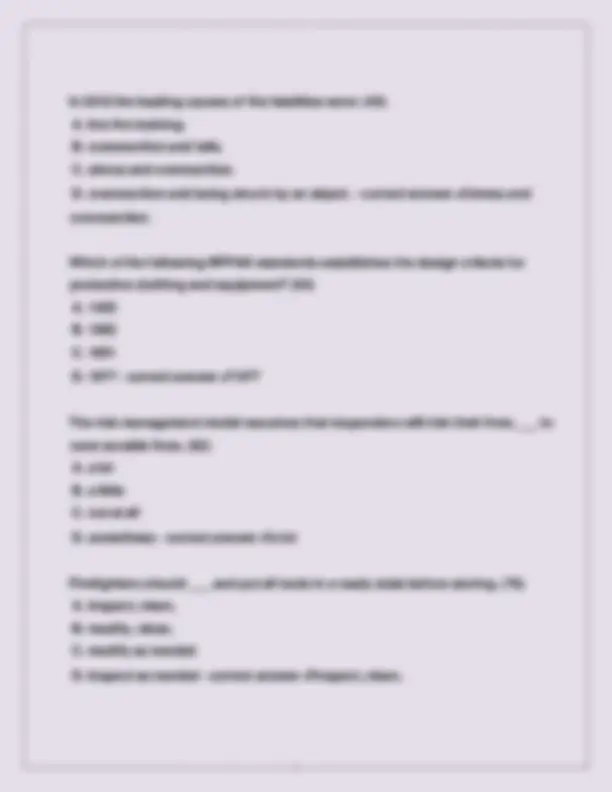
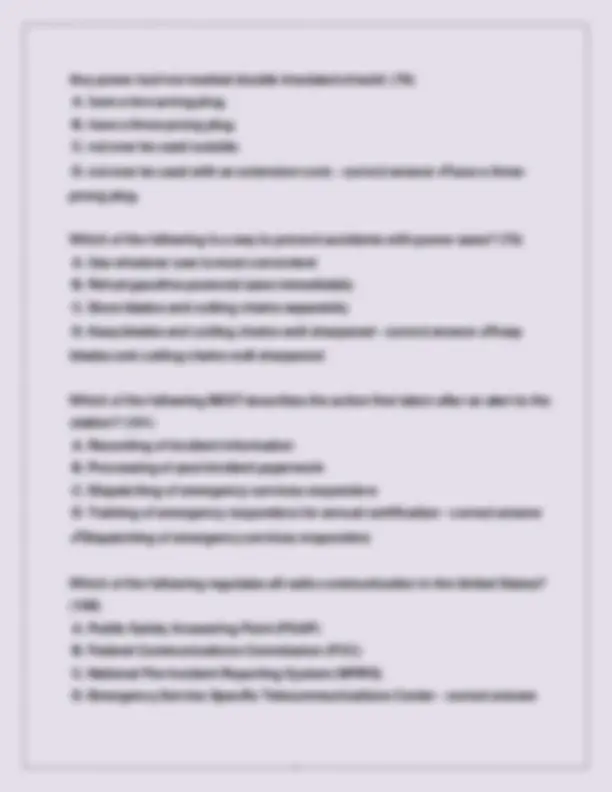
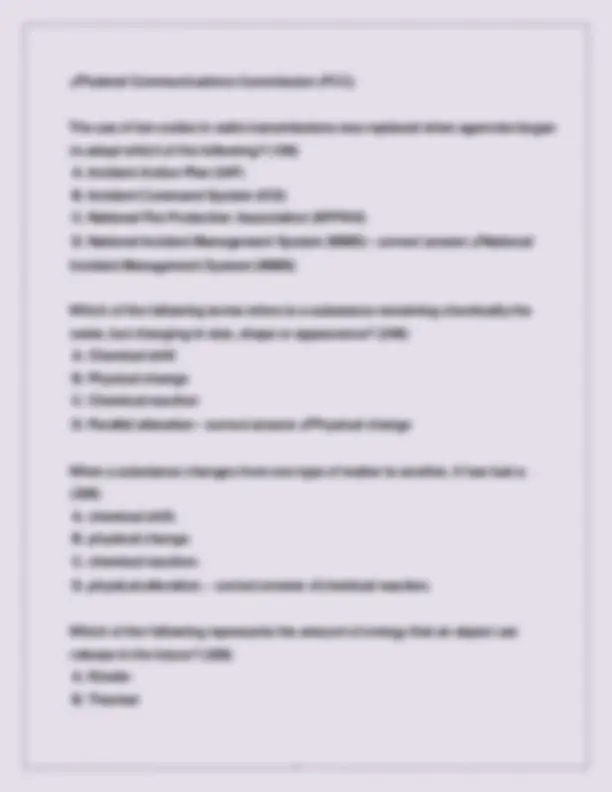
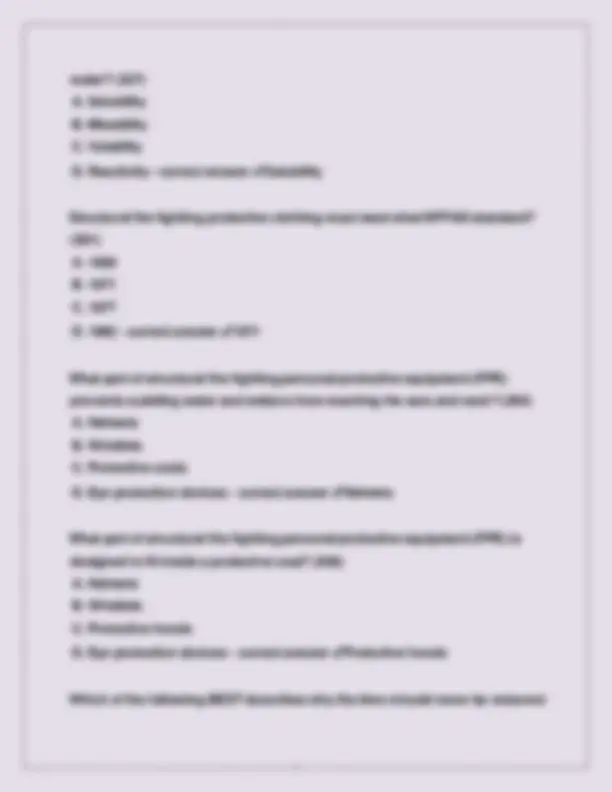
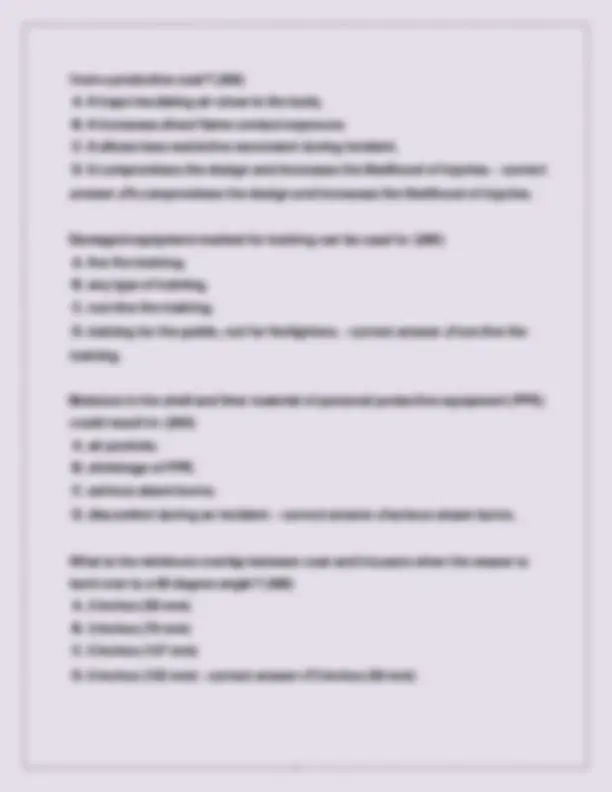
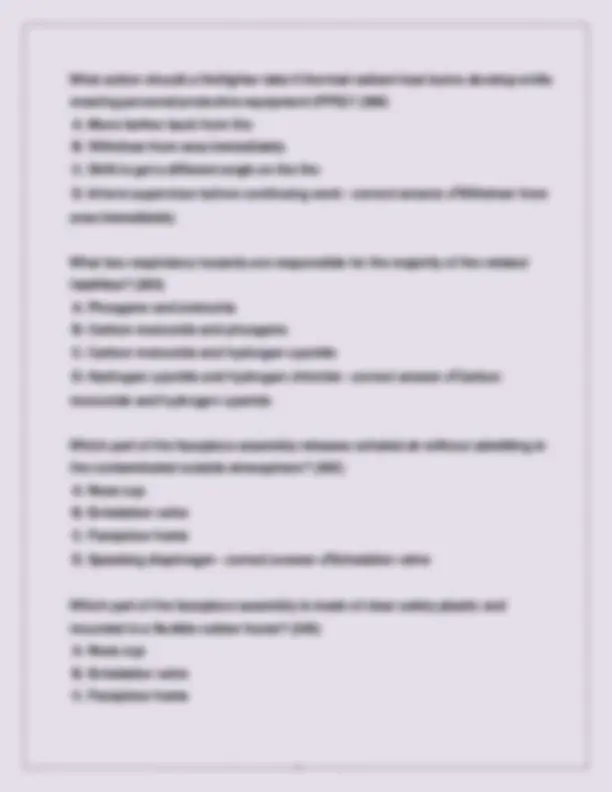
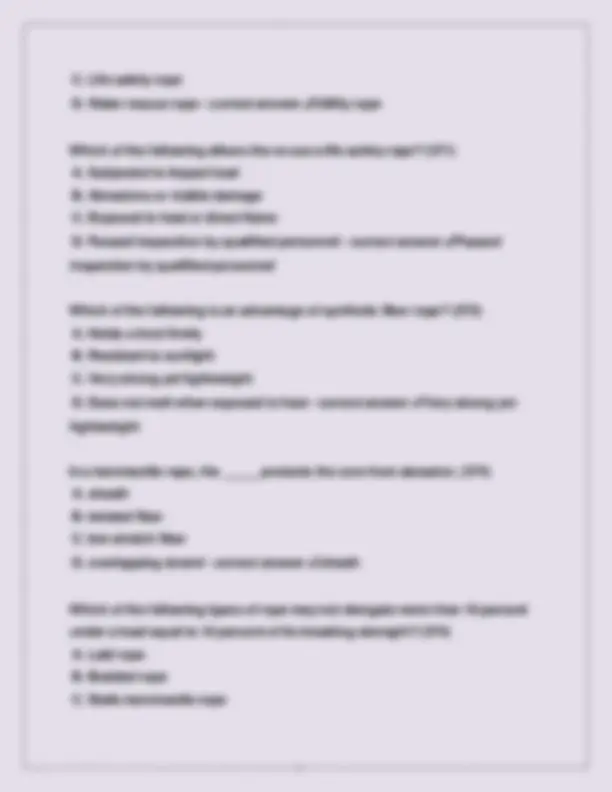
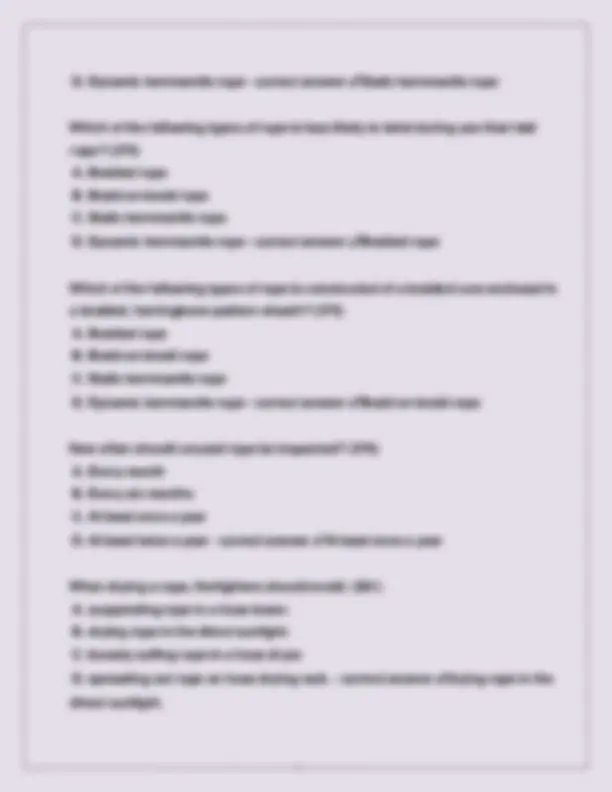
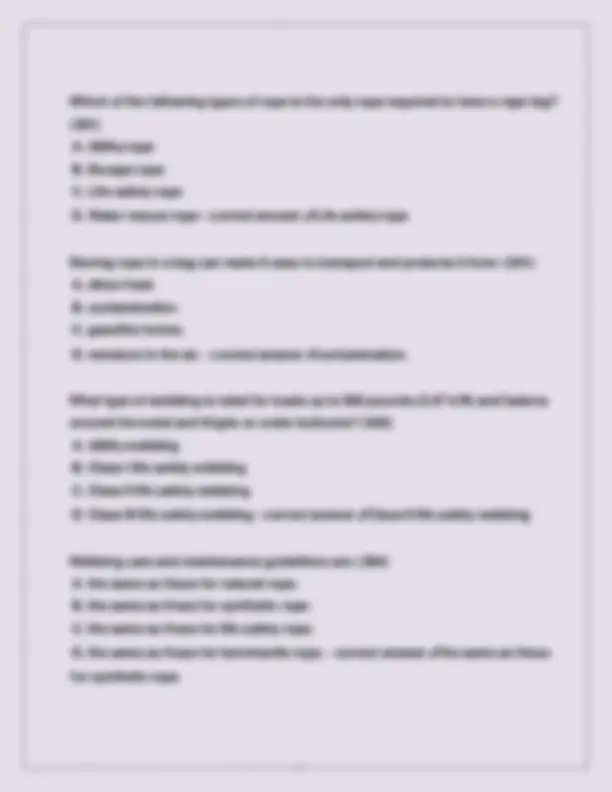
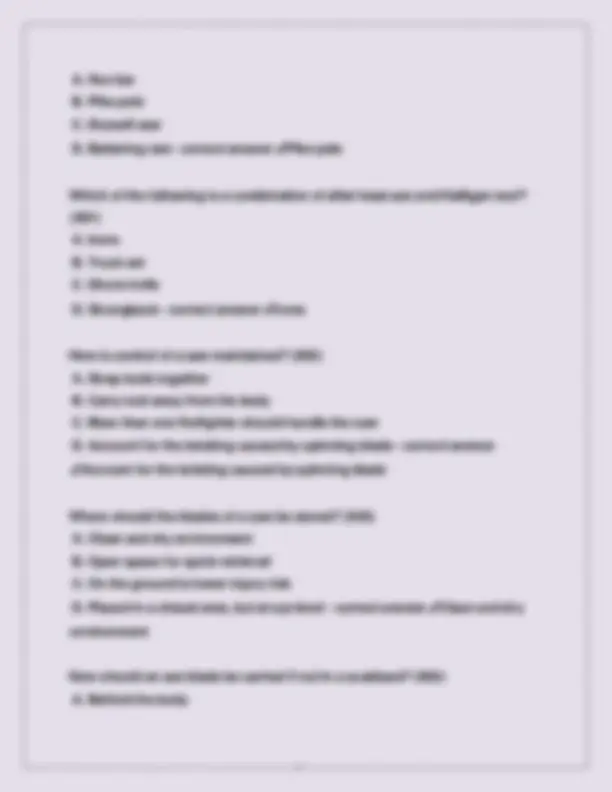
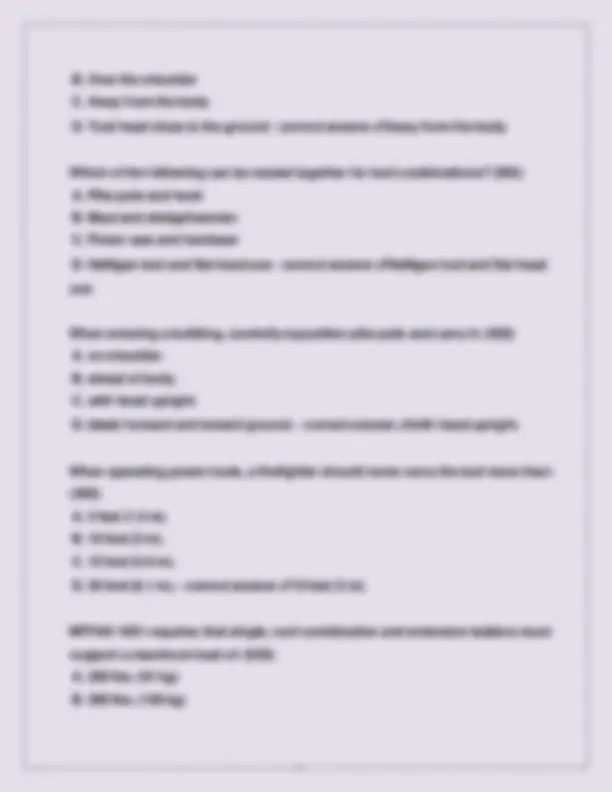
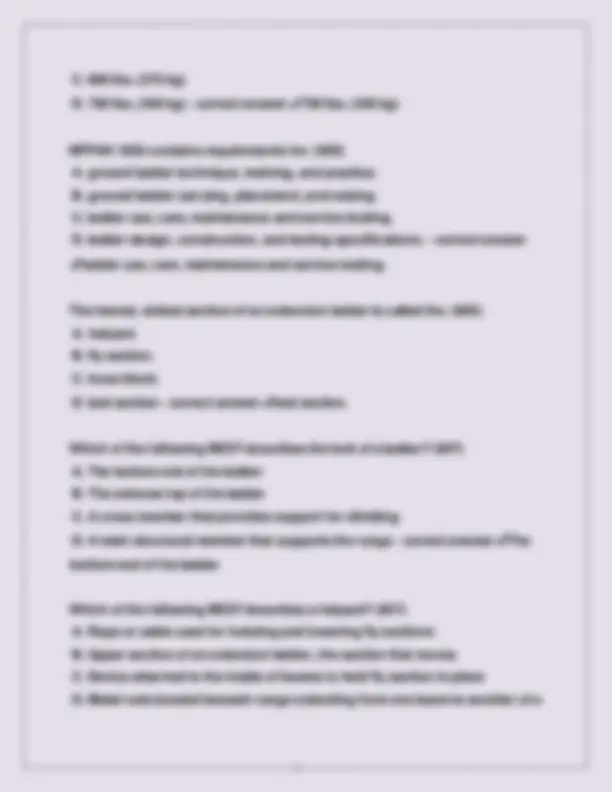
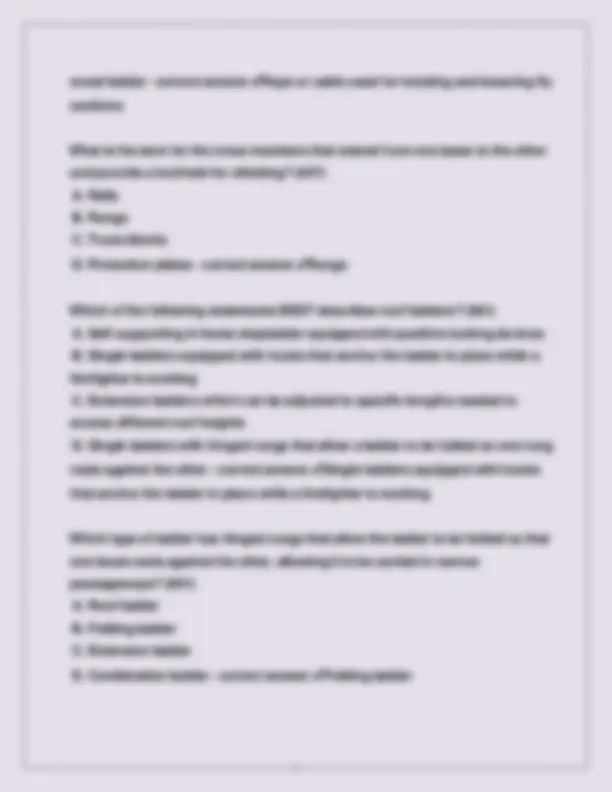
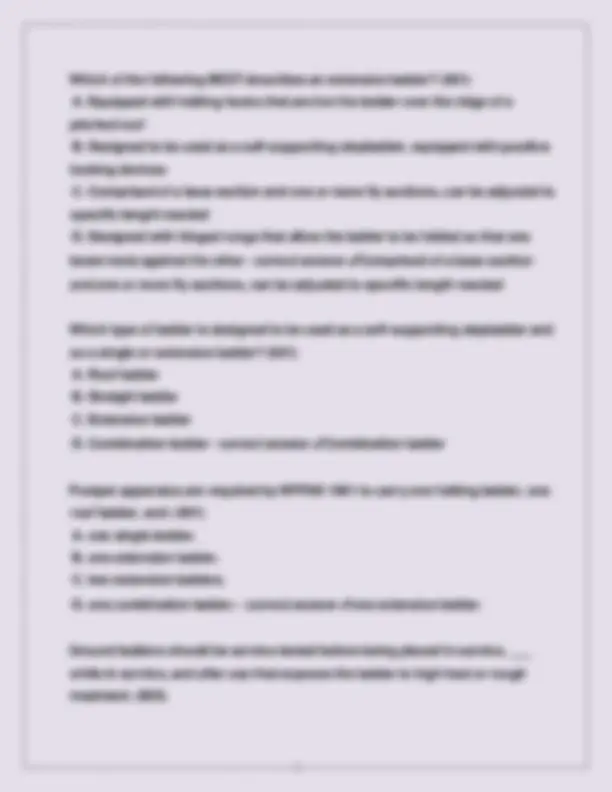
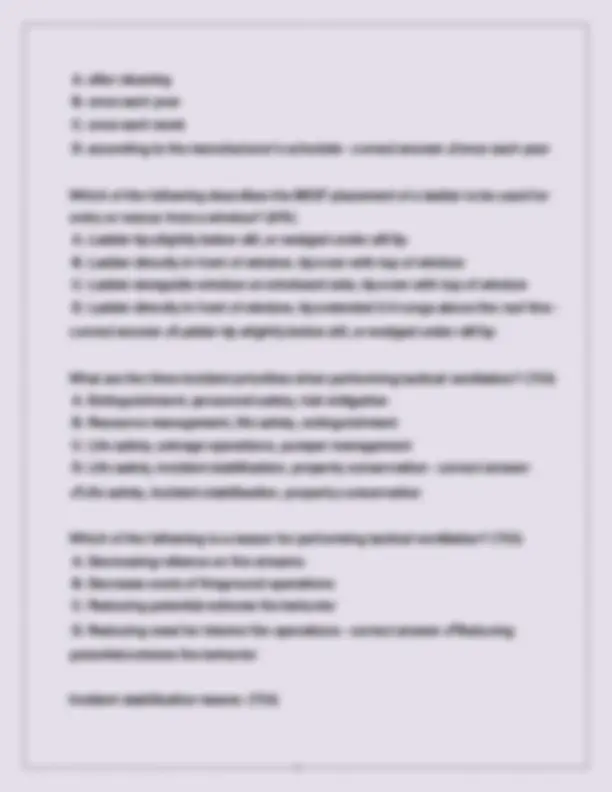
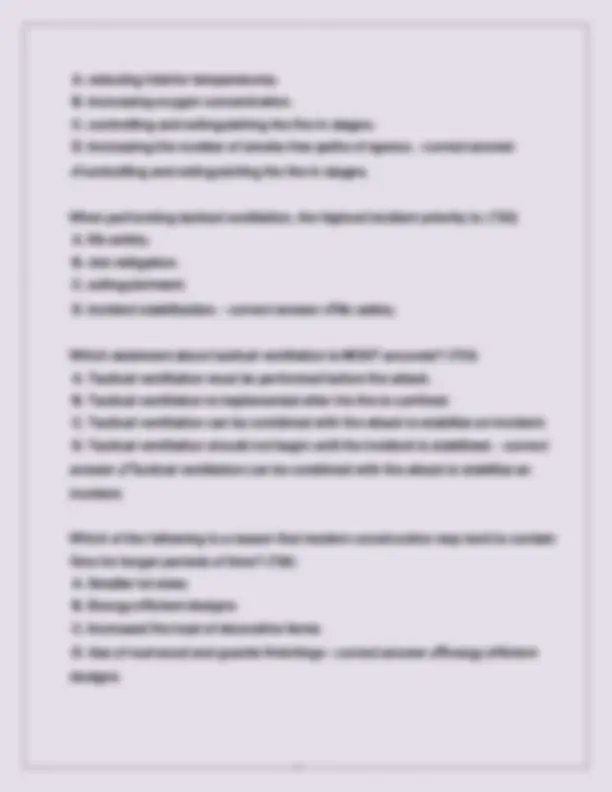
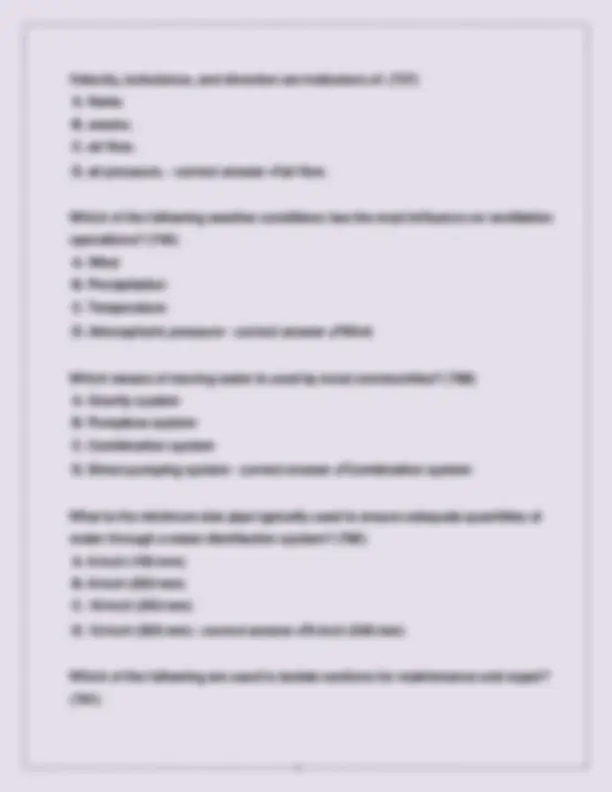
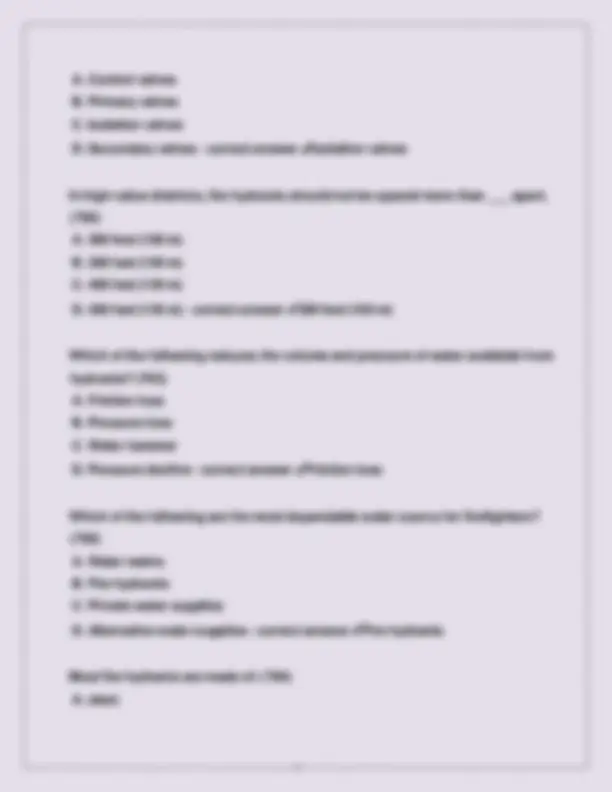
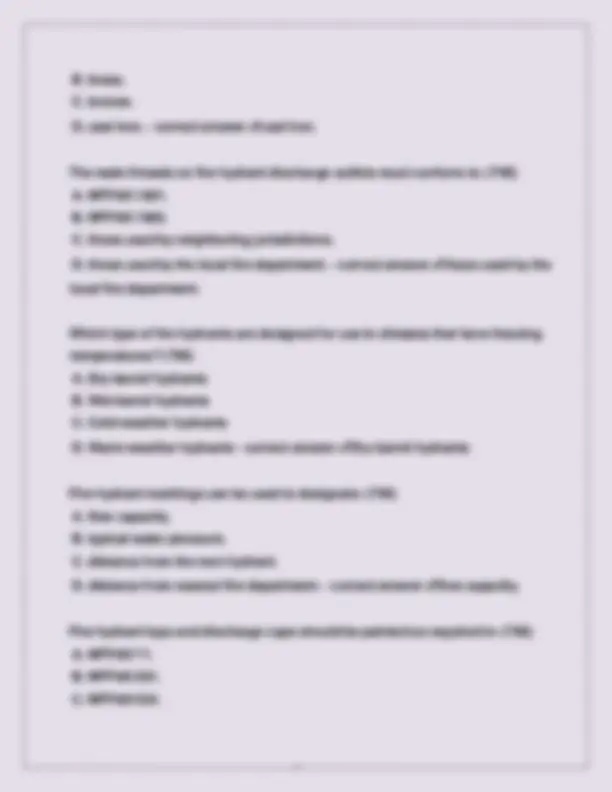
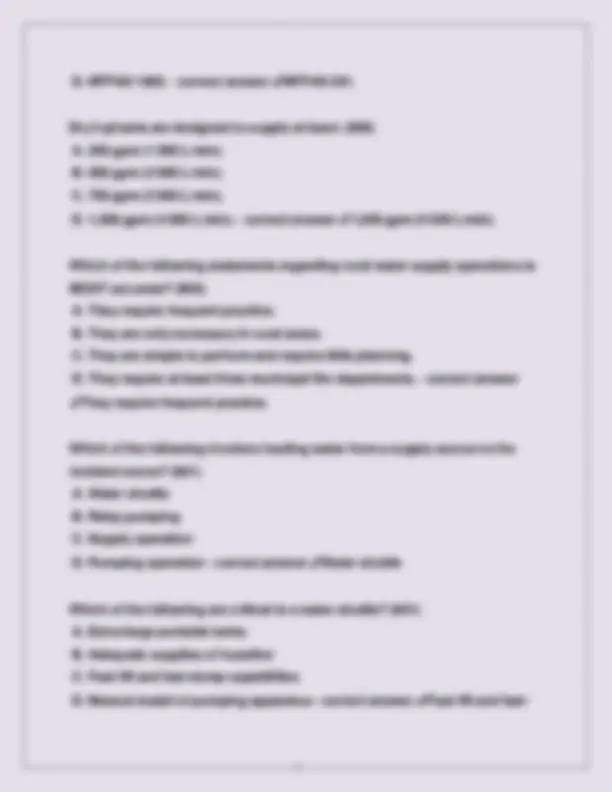
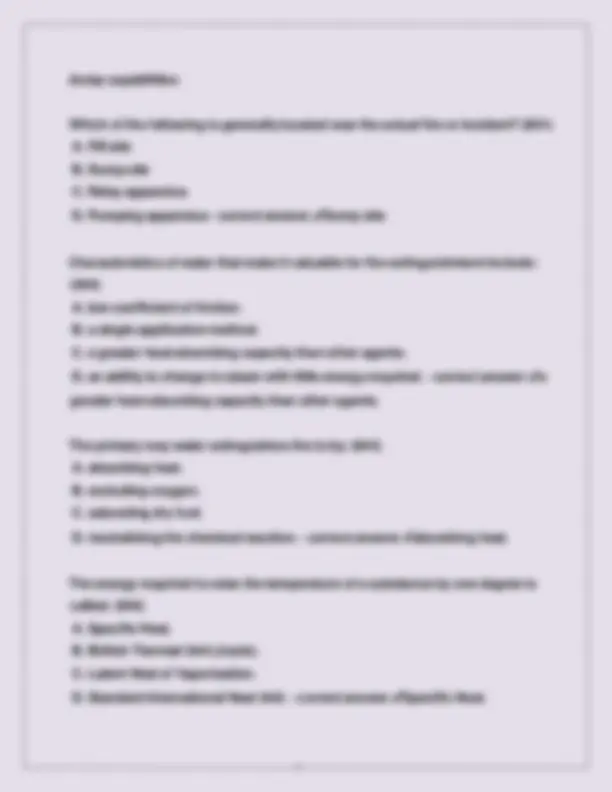

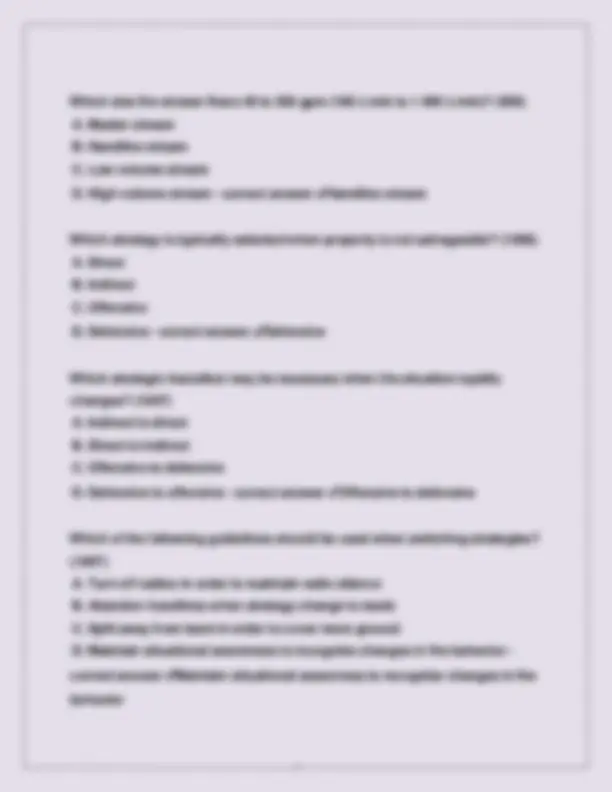
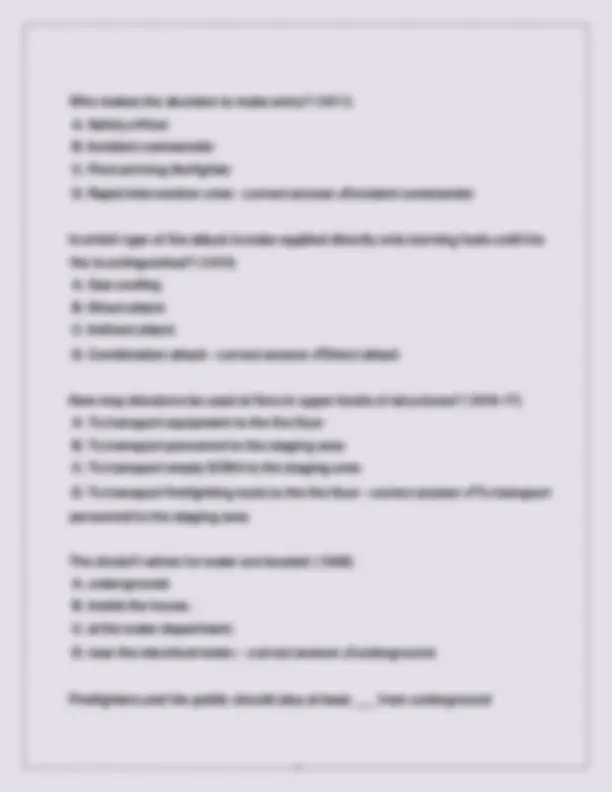
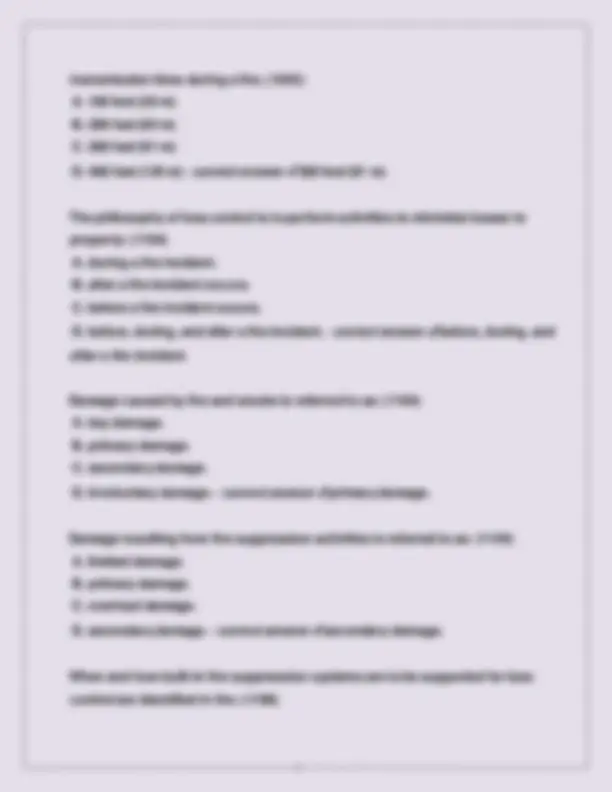
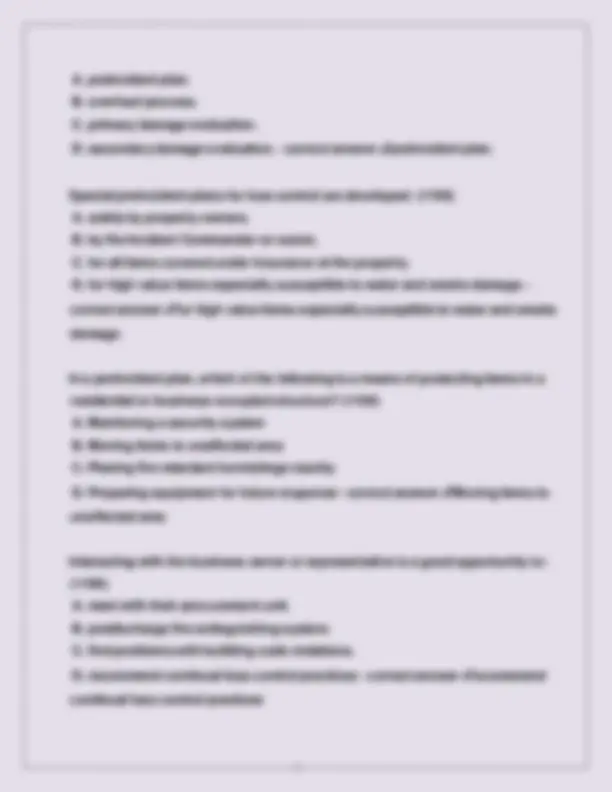
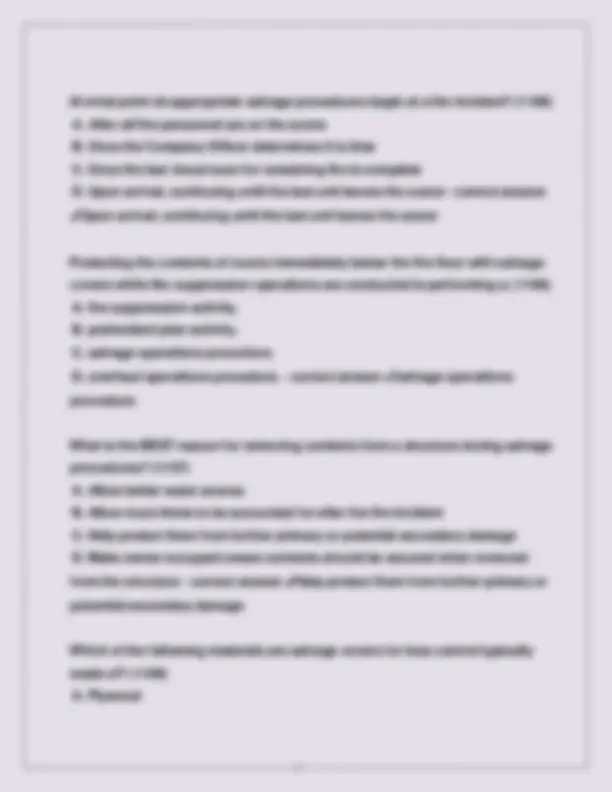
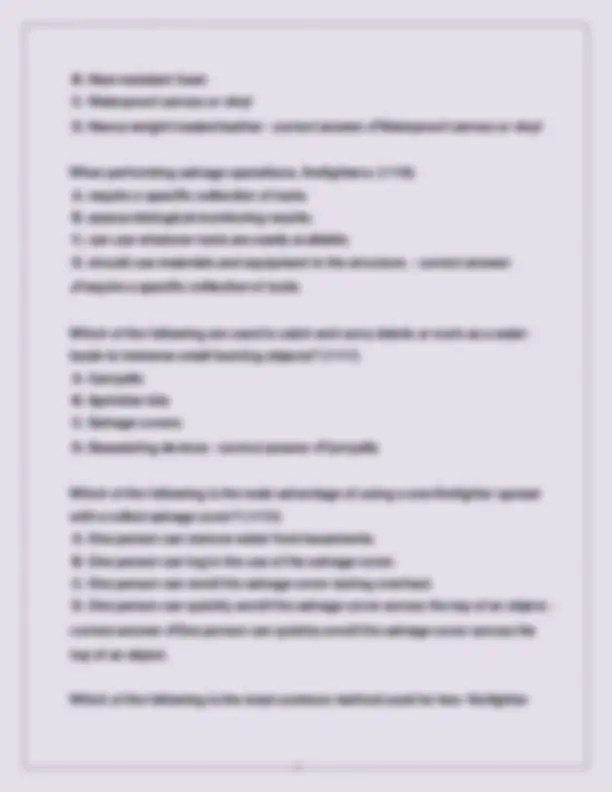
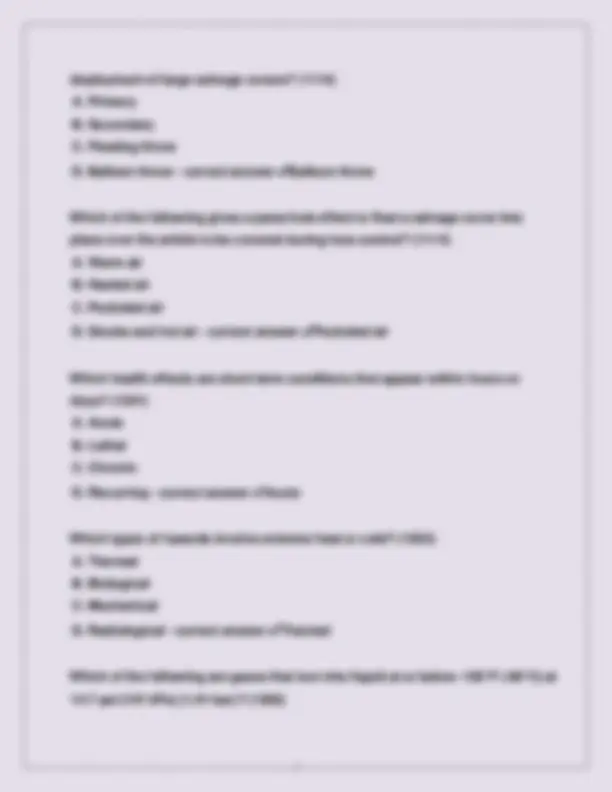
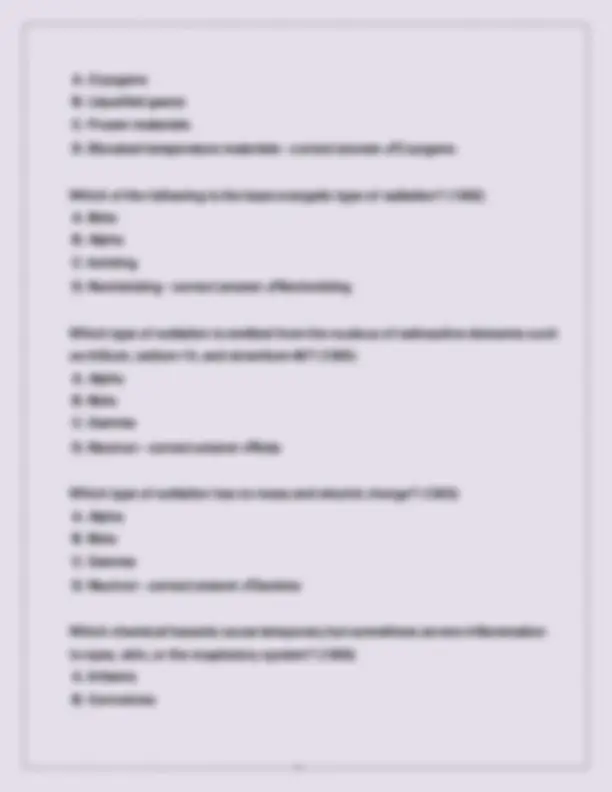
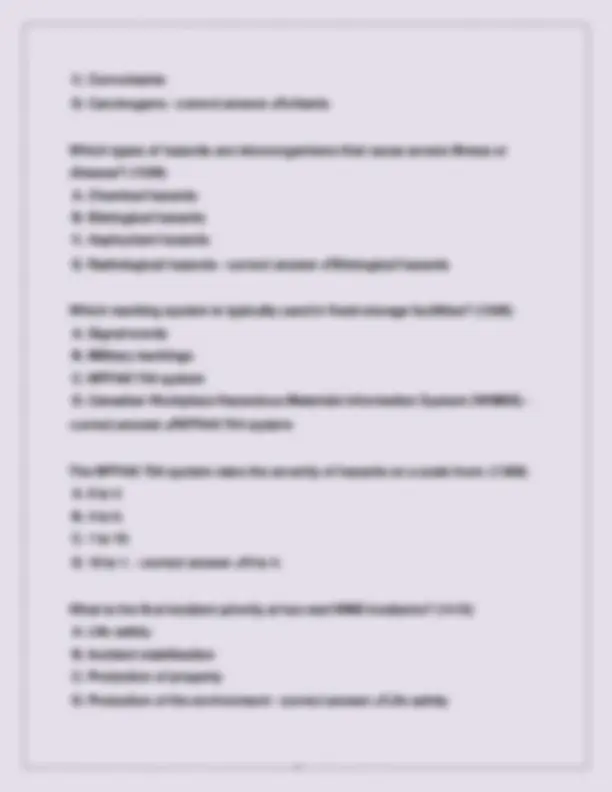
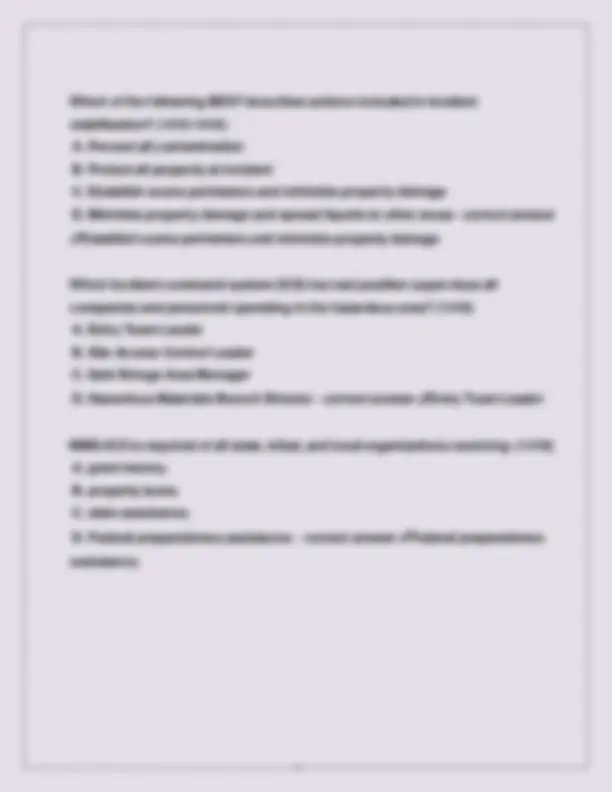


Study with the several resources on Docsity

Earn points by helping other students or get them with a premium plan


Prepare for your exams
Study with the several resources on Docsity

Earn points to download
Earn points by helping other students or get them with a premium plan
Community
Ask the community for help and clear up your study doubts
Discover the best universities in your country according to Docsity users
Free resources
Download our free guides on studying techniques, anxiety management strategies, and thesis advice from Docsity tutors
Firefighter 1 Final exam with correct answers
Typology: Exams
1 / 40

This page cannot be seen from the preview
Don't miss anything!

































What |type |of |company |performs |fire |suppression |duties |at |structure, |vehicle, |wildland, |and |other |types |of |fires? |(26) |A. |Truck |company |B. |Brush |company |C. |Engine |company |D. |Special |rescue |company |- |correct |answer |✔Engine |company What |NFPA® |standard |establishes |basic |training |criteria |for |Firefighter |I |and |Firefighter |II? |(27) |A. | 1001 |B. | 1002 |C. | 1021 |D. | 1582 |- |correct |answer |✔ 1001 What |is |the |main |duty |of |a |Firefighter |I? |(27) |A. |Assume |command |B. |Assign |tasks |to |be |performed |C. |Supervise |performance |of |assigned |tasks |D. |Perform |assigned |tasks |under |supervision |- |correct |answer |✔Perform |assigned |tasks |under |supervision Which |of |the |following |fire |service |organizational |principles |works |to |prevent |duplication |of |effort? |(33) |A. |Span |of |control |B. |Division |of |labor |C. |Unity |of |command |D. |Chain |of |command |- |correct |answer |✔Division |of |labor
Any |power |tool |not |marked |double |insulated |should: |(76) |A. |have |a |two-prong |plug. |B. |have |a |three-prong |plug. |C. |not |ever |be |used |outside. |D. |not |ever |be |used |with |an |extension |cord. |- |correct |answer |✔have |a |three- prong |plug. Which |of |the |following |is |a |way |to |prevent |accidents |with |power |saws? |(76) |A. |Use |whatever |saw |is |most |convenient |B. |Refuel |gasoline-powered |saws |immediately |C. |Store |blades |and |cutting |chains |separately |D. |Keep |blades |and |cutting |chains |well |sharpened |- |correct |answer |✔Keep |blades |and |cutting |chains |well |sharpened Which |of |the |following |BEST |describes |the |action |first |taken |after |an |alert |to |the |station? |(101) |A. |Recording |of |incident |information | |B. |Processing |of |post |incident |paperwork | |C. |Dispatching |of |emergency |services |responders | |D. |Training |of |emergency |responders |for |annual |certification |- |correct |answer |✔Dispatching |of |emergency |services |responders Which |of |the |following |regulates |all |radio |communication |in |the |United |States? |(109) |A. |Public |Safety |Answering |Point |(PSAP) |B. |Federal |Communications |Commission |(FCC) |C. |National |Fire |Incident |Reporting |System |(NFIRS) |D. |Emergency |Service |Specific |Telecommunications |Center |- |correct |answer
|✔Federal |Communications |Commission |(FCC) The |use |of |ten-codes |in |radio |transmissions |was |replaced |when |agencies |began |to |adopt |which |of |the |following? |(109) |A. |Incident |Action |Plan |(IAP) | |B. |Incident |Command |System |(ICS) |C. |National |Fire |Protection |Association |(NFPA®) |D. |National |Incident |Management |System |(NIMS) |- |correct |answer |✔National |Incident |Management |System |(NIMS) Which |of |the |following |terms |refers |to |a |substance |remaining |chemically |the |same, |but |changing |in |size, |shape |or |appearance? |(208) |A. |Chemical |shift |B. |Physical |change |C. |Chemical |reaction |D. |Parallel |alteration |- |correct |answer |✔Physical |change When |a |substance |changes |from |one |type |of |matter |to |another, |it |has |had |a: |(208) |A. |chemical |shift. |B. |physical |change. |C. |chemical |reaction. |D. |physical |alteration. |- |correct |answer |✔chemical |reaction. Which |of |the |following |represents |the |amount |of |energy |that |an |object |can |release |in |the |future? |(209) |A. |Kinetic |B. |Thermal |
What |product |of |combustion |is |the |most |common |product |in |structure |fires? |(215) |A. |Toxic |smoke |B. |Thermal |energy |C. |Hydrogen |cyanide |D. |Carbon |monoxide |- |correct |answer |✔Carbon |monoxide What |source |of |thermal |energy |is |the |most |common |source |of |heat |in |combustion |reactions? |(217) |A. |Radiant |energy | |B. |Electrical |energy |C. |Chemical |energy |D. |Mechanical |energy |- |correct |answer |✔Chemical |energy What |method |of |heat |transfer |occurs |when |a |material |is |heated |as |the |result |of |direct |contact |with |a |heat |source? |(220) |A. |Potential | |B. |Radiation |C. |Conduction |D. |Convection |- |correct |answer |✔Conduction What |type |of |fuel |can |be |the |most |dangerous |of |all |the |types? |(225) |A. |Solid |B. |Liquid |C. |Gaseous |D. |Chemical |- |correct |answer |✔Gaseous What |term |is |used |to |describe |the |extent |to |which |a |substance |will |mix |with
|water? |(227) |A. |Solubility | |B. |Mixability |C. |Volatility |D. |Reactivity |- |correct |answer |✔Solubility Structural |fire |fighting |protective |clothing |must |meet |what |NFPA® |standard? |(261) |A. | 1500 |B. | 1971 |C. | 1977 |D. | 1982 |- |correct |answer |✔ 1971 What |part |of |structural |fire |fighting |personal |protective |equipment |(PPE) |prevents |scalding |water |and |embers |from |reaching |the |ears |and |neck? |(264) |A. |Helmets |B. |Wristlets |C. |Protective |coats |D. |Eye |protection |devices |- |correct |answer |✔Helmets What |part |of |structural |fire |fighting |personal |protective |equipment |(PPE) |is |designed |to |fit |inside |a |protective |coat? |(266) |A. |Helmets |B. |Wristlets |C. |Protective |hoods |D. |Eye |protection |devices |- |correct |answer |✔Protective |hoods Which |of |the |following |BEST |describes |why |the |liner |should |never |be |removed
What |action |should |a |firefighter |take |if |thermal |radiant |heat |burns |develop |while |wearing |personal |protective |equipment |(PPE)? |(280) |A. |Move |farther |back |from |fire |B. |Withdraw |from |area |immediately | |C. |Shift |to |get |a |different |angle |on |the |fire |D. |Inform |supervisor |before |continuing |work |- |correct |answer |✔Withdraw |from |area |immediately What |two |respiratory |hazards |are |responsible |for |the |majority |of |fire-related |fatalities? |(285) |A. |Phosgene |and |ammonia |B. |Carbon |monoxide |and |phosgene |C. |Carbon |monoxide |and |hydrogen |cyanide |D. |Hydrogen |cyanide |and |hydrogen |chloride |- |correct |answer |✔Carbon |monoxide |and |hydrogen |cyanide Which |part |of |the |facepiece |assembly |releases |exhaled |air |without |admitting |in |the |contaminated |outside |atmosphere? |(292) |A. |Nose |cup |B. |Exhalation |valve |C. |Facepiece |frame |D. |Speaking |diaphragm |- |correct |answer |✔Exhalation |valve Which |part |of |the |facepiece |assembly |is |made |of |clear |safety |plastic |and |mounted |in |a |flexible |rubber |frame? |(292) |A. |Nose |cup |B. |Exhalation |valve |C. |Facepiece |frame
|D. |Speaking |diaphragm |- |correct |answer |✔Facepiece |frame Which |of |the |following |APR |effectiveness |clues |is |monitored |by |being |aware |of |how |labored |a |firefighter's |breathing |is? |(295) |A. |Time |B. |Weight |C. |Taste |and |smell |D. |Resistance-to-breathing-indicators |- |correct |answer |✔Resistance-to- breathing-indicators Which |of |the |following |limitations |of |respiratory |protection |may |cause |the |wearer |to |deplete |the |air |supply |rapidly? |(295) |A. |Lack |of |agility |B. |Psychological |limitations | |C. |Lack |of |physical |condition |D. |Inadequate |pulmonary |capacity |- |correct |answer |✔Psychological |limitations When |donning |SCBA, |all |straps |on |the |harness |assembly |and |facepiece |should |be: |(298) |A. |fully |extended. | |B. |partially |extended. | |C. |adjusted |individually. |D. |adjusted |per |local |SOPs. |- |correct |answer |✔fully |extended. Portable |fire |extinguishers |should |be |chosen |based |on |the: |(340) |A. |heat |of |the |fire. |B. |type |of |fuel |that |is |burning. |C. |amount |of |agent |required |to |extinguish |the |fire.
|C. |Life |safety |rope |D. |Water |rescue |rope |- |correct |answer |✔Utility |rope Which |of |the |following |allows |the |re-use |a |life |safety |rope? |(371) |A. |Subjected |to |impact |load |B. |Abrasions |or |visible |damage |C. |Exposed |to |heat |or |direct |flame |D. |Passed |inspection |by |qualified |personnel |- |correct |answer |✔Passed |inspection |by |qualified |personnel Which |of |the |following |is |an |advantage |of |synthetic |fiber |rope? |(373) |A. |Holds |a |knot |firmly | |B. |Resistant |to |sunlight |C. |Very |strong |yet |lightweight |D. |Does |not |melt |when |exposed |to |heat |- |correct |answer |✔Very |strong |yet |lightweight In |a |kernmantle |rope, |the |_____ |protects |the |core |from |abrasion. |(374) |A. |sheath |B. |twisted |fiber |C. |low |stretch |fiber |D. |overlapping |strand |- |correct |answer |✔sheath Which |of |the |following |types |of |rope |may |not |elongate |more |than | 10 |percent |under |a |load |equal |to | 10 |percent |of |its |breaking |strength? |(374) |A. |Laid |rope | |B. |Braided |rope |C. |Static |kernmantle |rope
|D. |Dynamic |kernmantle |rope |- |correct |answer |✔Static |kernmantle |rope Which |of |the |following |types |of |rope |is |less |likely |to |twist |during |use |than |laid |rope? |(375) |A. |Braided |rope |B. |Braid-on-braid |rope |C. |Static |kernmantle |rope |D. |Dynamic |kernmantle |rope |- |correct |answer |✔Braided |rope Which |of |the |following |types |of |rope |is |constructed |of |a |braided |core |enclosed |in |a |braided, |herringbone-pattern |sheath? |(375) |A. |Braided |rope |B. |Braid-on-braid |rope |C. |Static |kernmantle |rope | |D. |Dynamic |kernmantle |rope |- |correct |answer |✔Braid-on-braid |rope How |often |should |unused |rope |be |inspected? |(376) |A. |Every |month |B. |Every |six |months |C. |At |least |once |a |year |D. |At |least |twice |a |year |- |correct |answer |✔At |least |once |a |year When |drying |a |rope, |firefighters |should |avoid: |(381) |A. |suspending |rope |in |a |hose |tower. |B. |drying |rope |in |the |direct |sunlight. |C. |loosely |coiling |rope |in |a |hose |dryer. |D. |spreading |out |rope |on |hose |drying |rack. |- |correct |answer |✔drying |rope |in |the |direct |sunlight.
Which |part |of |the |rope |is |used |for |hoisting? |(384) |A. |Knot |B. |Working |C. |Running |D. |Standing |- |correct |answer |✔Running Which |part |of |the |rope |is |used |to |tie |a |knot |or |hitch? |(384) |A. |Knot |B. |Working |C. |Running |D. |Standing |- |correct |answer |✔Working Removing |the |slack |in |rope |after |tying |a |knot |is |called: |(384) |A. |dressing. |B. |working. |C. |running. |D. |standing. |- |correct |answer |✔dressing. Which |type |of |knot |can |be |used |to |secure |a |victim's |hands |or |feet |to |drag |the |victim |to |safety? |(388) |A. |Bowline |B. |Handcuff |C. |Figure-eight |D. |Becket |bend |- |correct |answer |✔Handcuff Which |of |the |following |statements |about |forcible |entry |is |MOST |accurate? |(573-
|A. |Forcible |entry |should |only |be |used |in |structural |buildings.
|B. |Forcible |entry |causes |minimal |damage |when |applied |properly. |C. |Forcible |entry |will |cause |significant |damage |even |done |properly. |D. |Forcible |entry |can |be |used |even |when |normal |means |of |access |are |available. |- |correct |answer |✔Forcible |entry |will |cause |significant |damage |even |done |properly. Which |of |the |following |personnel |determines |where |to |perform |forcible |entry? |(574) |A. |Fire |Chief |B. |Firefighter |C. |Safety |Officer |D. |Incident |Commander |- |correct |answer |✔Incident |Commander Which |of |the |following |should |be |done |after |"try |before |you |pry"? |(574) |A. |Pry |the |door |or |window |B. |Force |a |window |to |reach |lock |on |door |C. |Determine |correct |tool |to |force |entry |D. |Look |for |lockbox |near |the |main |entrance |- |correct |answer |✔Look |for |lockbox |near |the |main |entrance Which |of |the |following |should |be |equipped |with |kickback |protection |and |brakes |for |safety? |(586) |A. |Chain |saw |B. |Rotary |saw |C. |Circular |saw |D. |Reciprocating |saw |- |correct |answer |✔Chain |saw Which |of |the |following |is |an |example |of |a |push/pull |tool? |(589)
|B. |Over |the |shoulder |C. |Away |from |the |body |D. |Tool |head |close |to |the |ground |- |correct |answer |✔Away |from |the |body Which |of |the |following |can |be |nested |together |for |tool |combinations? |(593) |A. |Pike |pole |and |hook | |B. |Maul |and |sledgehammer |C. |Power |saw |and |handsaw |D. |Halligan |tool |and |flat-head |axe |- |correct |answer |✔Halligan |tool |and |flat-head |axe When |entering |a |building, |carefully |reposition |pike |pole |and |carry |it: |(593) |A. |on |shoulder. |B. |ahead |of |body. |C. |with |head |upright. |D. |blade |forward |and |toward |ground. |- |correct |answer |✔with |head |upright. When |operating |power |tools, |a |firefighter |should |never |carry |the |tool |more |than: |(593) |A. | 5 |feet |(1.5 |m). |B. | 10 |feet |(3 |m). |C. | 15 |feet |(4.6 |m). |D. | 20 |feet |(6.1 |m). |- |correct |answer |✔ 10 |feet |(3 |m). NFPA® | 1931 |requires |that |single, |roof |combination |and |extension |ladders |must |support |a |maximum |load |of: |(655) |A. | 200 |lbs. |(91 |kg) |B. | 300 |lbs. |(136 |kg)
|C. | 600 |lbs. |(272 |kg) |D. | 750 |lbs. |(340 |kg) |- |correct |answer |✔ 750 |lbs. |(340 |kg) NFPA® | 1932 |contains |requirements |for: |(655) |A. |ground |ladder |technique, |training, |and |practice. |B. |ground |ladder |carrying, |placement, |and |raising. |C. |ladder |use, |care, |maintenance |and |service |testing. |D. |ladder |design, |construction, |and |testing |specifications. |- |correct |answer |✔ladder |use, |care, |maintenance |and |service |testing. The |lowest, |widest |section |of |an |extension |ladder |is |called |the: |(655) |A. |halyard. |B. |fly |section. |C. |truss |block. |D. |bed |section |- |correct |answer |✔bed |section. Which |of |the |following |BEST |describes |the |butt |of |a |ladder? |(657) |A. |The |bottom |end |of |the |ladder |B. |The |extreme |top |of |the |ladder |C. |A |cross |member |that |provides |support |for |climbing |D. |A |main |structural |member |that |supports |the |rungs |- |correct |answer |✔The |bottom |end |of |the |ladder Which |of |the |following |BEST |describes |a |halyard? |(657) |A. |Rope |or |cable |used |for |hoisting |and |lowering |fly |sections |B. |Upper |section |of |an |extension |ladder, |the |section |that |moves |C. |Device |attached |to |the |inside |of |beams |to |hold |fly |section |in |place |D. |Metal |rods |located |beneath |rungs |extending |from |one |beam |to |another |of |a